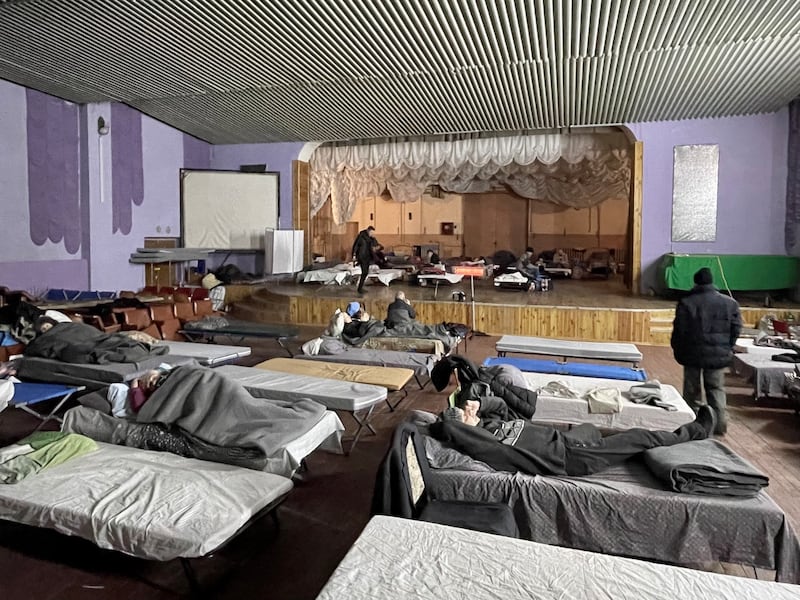Sitting on two of the camp beds that now fill a small concert hall in Pavlohrad in eastern Ukraine, Lyubov (76) and Viktor (83) wonder what is next for them and for Pokrovsk, the hometown they have reluctantly fled to escape Russian bombardment.
“It’s a lovely town,” says Lyubov. “Or it was.”
About 60,000 people lived in Pokrovsk before Russia’s full-scale invasion of Ukraine in February 2022, but only about 7,000 remain as the coal-mining town endures daily shelling and air strikes and Moscow’s troops try to sever its main road link to the small Kyiv-held cities of Pavlohrad, 100km to the west, and Kostyantynivka 50km to the east.
“We held on and held on, but we just couldn’t do it any longer. A guided bomb landed near the house and it was basically destroyed – the roof and windows and doors were all badly damaged,” Lyubov says. “We’re still dreaming of going back. But there’s nothing to go back to now.”
The couple, who have been together for more than 50 years, worked in Pokrovsk all their lives, including in the big coal mines that were the economic powerhouse of the Donetsk region and are a heavy loss to Ukraine’s war-crippled industrial sector.
[ Daniel McLaughlin: Last stop on the front lineOpens in new window ]
Now they have only a few belongings in the bags they could carry, and pensions that amount jointly to less than €500. They will each also probably receive a monthly state payment to displaced people of between €45 and €70.
“We don’t know what to do. It’s expensive to rent a flat somewhere else. We need to think but there’s nothing up here to think with,” Lyubov says, tapping the side of her head and smiling despite her tiredness and the stress of their situation.
“Sorry for complaining so much,” she adds.

According to the United Nations refugee agency (UNHCR), 12.7 million people in Ukraine need humanitarian aid and more than 10.6 million people have been displaced by the war inside and outside the country.
“The intensified hostilities have led to an increased level of new displacement and evacuations since last summer, particularly from the three frontline regions of Donetsk, Kharkiv and Sumy,” says Elisabeth Arnsdorf Haslund, a spokeswoman for the UNHCR in Ukraine.
“Since August 2024 an estimated more than 205,000 people are assessed to have been displaced or evacuated from their homes in these three regions, according to regional authorities. In Donetsk region alone more than 154,000 people have fled frontline communities and towns” during that period, she adds.
On some nights last summer the concert hall in Pavlohrad’s cultural centre was full of displaced people and others slept in tents outside. That would be impossible now that snow covers the freezing ground but workers and volunteers with local aid groups that run the shelter – many of whom also fled homes further east since Russia began attacking the region in 2014 – say that only about 40-50 people now arrive each day, and most move on quickly on free train and bus services to other parts of Ukraine.
Even if the US succeeds in its push to end the fighting in Ukraine, the legacy of Europe’s biggest war since 1945 will affect its people for many years.
“While a potential ceasefire or peace negotiation may put a stop to the daily attacks and bombs, rebuilding and recovery will not happen overnight, and humanitarian needs will persist,” Arnsdorf Haslund says.
“Millions will still require humanitarian support, while recovery efforts start ... While we know from many refugees and internally displaced people that they long to return, it is also a fact that for many, this is simply not possible currently, either because their homes are in occupied territory or because their homes are amongst the more than two million destroyed or damaged.”
[ Moscow raises new Nato demand as US and Russia meet for Ukraine talksOpens in new window ]
Thousands of people who want to stay closer to their now occupied or front-line hometowns in Donetsk region have moved to Mezhova, a small town sitting between Pavlohrad and Pokrovsk and just inside the province of Dnipropetrovsk.
“We stayed for as long as we could in Pokrovsk but it got too dangerous and we moved here in December,” says Denys Tymyk, who already runs his own busy coffee shop in Mezhova, which is now a hub for soldiers moving to and from the front.

“Unfortunately, our life in Pokrovsk is probably over. No schools are working, there are no gas or electricity or water supplies – it’s all destroyed,” adds the 40-year-old father of two boys.
“Whatever happens, it will probably be impossible to live there for 10 or 20 years. The longer the mine stays closed the harder it will be to restart it. And then it might not be worth repairing, so the whole future of the city is in doubt.”
Tymyk says his family now feels safe, despite the frequent thud of artillery fire from a front line that is now less than 20km from Mezhova.
“People here have been welcoming. This is a good little town,” he says. “But it’s not home. It’s not the place you were born and grew up, where you know someone on every street, somewhere full of memories.”






















